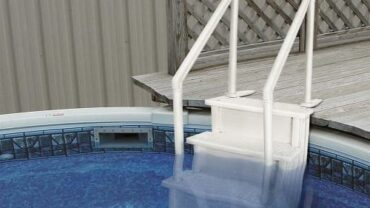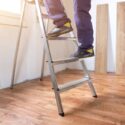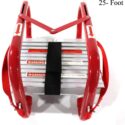Portable Ladder Safety Tips and Using Guide
Portable ladders are widely preferred for DIYs, construction site work, and much more for sure. Without the help of ladders, it seems impossible to do the same task at the same speed. The manpower required for a job increases without the help of a ladder, and reaching heights location is an impractical thing. Due to this, portable ladders demand never goes down.
There is an intense number of options available in portable ladders, and you can look for several aspects during the purchase. From choosing between type to length, the variety is pretty impressive. However, working with a portable ladder is not as safe as it looks like in the tutorial videos. Someone afraid of height usually can’t go above the height of 20 meters using portable ladders.
Contents
Ladder Safety Tips and Using Guide
Meanwhile, plenty of accidents happen while working on a ladder; learning about safety tips can help. It is not about only the person who is working with a ladder, but also about the safety of other workers near the ladder. Falling from a ladder can risk your life as well as others also. Due to this, there are pretty strict laws about the construction site portable ladders.
Here are some key tips that can enlarge your knowledge regarding portable ladder safety and improve safety for yourself. Have a look
#1. Inspect The Ladder
Before using a ladder, it would be a better choice to inspect the ladder. Each type of ladder has steps, and these are connected using several methods. You can look for joints and any kind of cracks while inspecting the ladder. It is not about checking every day because that will be a wastage of time and money in the construction site. But, you can spend a couple of seconds to directly visible problems. While inspecting a ladder, you can touch and press hard all the steps to ensure that they are perfect.
#2. Tagging Damaged Ladders
You can find plenty of damaged tools and ladders at a construction site, probably the most common stuff in the damaged list. After finding a damaged ladder, it would be better to tag Damaged sticker, logo, or print on it until it gets repaired. It is about the safety of other works, which might use a ladder without inspecting it. The safety factor is always the most important one, and you should not avoid checking for the essential things.
#3. Maintain 3-Point Contact
There is a rule to use a ladder that says that the worker should have 3-point contact to the ladder in all cases. In order words, you should have both feet to the ladder and one hand holding the step. It means you have only one hand spared that can be used for several purposes like drilling holes and more.
#4. Clean The Ladder
At a construction site, slippery materials are quite common, and having anything slippery on the ladder increases the risk. Instead of rinsing the ladder with water, use a wet fabric to clean off the slippery liquid from the steps. It might take a little time, but you can expect a safe use. Using this method ensures that you are maintaining proper contact and not going to fall on someone by slipping. The risk factor reduces when the ladder is properly clean.
#5. Clean Ladder’s Feet
There are several types of ladders, and the number of feet depends upon the type. Using an extension ladder is slightly risky between it has two-point contact to the ground and two-point contact to the wall. When you are using an extension ladder, you should check out the feet of the ladder and the place where you are standing it. Find a stable surface and must ensure that there is nothing slippery under the feet. The slippery surface can cause more issues. Cleaning feet of the ladder along with the inspection of ground, will help you expect safer use.
#6. Load Rating
There is a load rating of the ladder that you should be considering. Exceeding the limit can bend your ladder in a few seconds, and then it will crack in between. To avoid these problems, you can consider portable ladders with higher load capacity for safer use. The overall problem of the ladder comes from excess weight or poor maintenance. One more tip is to avoid keeping the ladder in water or moist area; otherwise, it starts degrading, and the load capacity decreases with the time.
#7. Avoid Top Rung Of Ladder
Using the top step or rung of the ladder is always risky. When you are on a self-supporting ladder and placing your feet on the top rung, chances of slipping increases, balancing yourself will be typical, and it would be better to stay two-step down from the top rung for safety reason. You can make sure that you don’t use the self-support ladder to reach such heights and then to use the top rung because the risk factor is extremely high in such cases. The angel might be good enough to support you, but when a ladder slips, you can’t stop it from falling.
Final Words
These are seven important safety tips from the experts that you should be considering. There are many other safety factors to consider which will protect you during the long term use. Make sure that you choose a quality made portable ladder and use it in the right manner for the extreme level of safety.
Related Topics:



